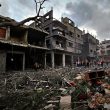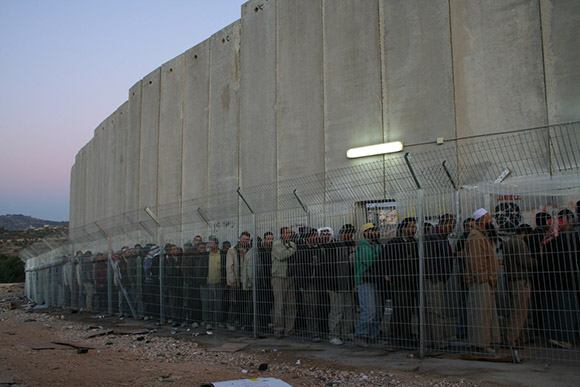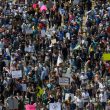On the 50th anniversary of the Six Day War and the upcoming 100th anniversary of the Balfour Declaration, Cillian Gillespie looks at how the occupation of Palestine can be ended and how a just and democratic solution, upholding the national rights of both Palestinians and Israeli Jews, can be brought into existence.
June 2017 marked a poignant anniversary for the Palestinian people. Fifty years had passed since the Israeli state began its criminal and colonial occupation of the West Bank, Gaza and East Jerusalem, in the aftermath of the Six Day War against its neighbouring Arab states.
Half a century on, the situation facing the Palestinian masses has never been more desperate. Those living in the occupied West Bank and East Jerusalem do so under a regime of military rule and apartheid, with over five hundred Israeli army checkpoints dotted across the land and with major restrictions on their freedom of movement. Since the beginning of the occupation of the West Bank and Gaza, an estimated 700,000 Palestinians have been incarcerated in the dungeons of Israel’s prison system.
Palestinian land and resources are stolen to make way for the criminal enterprise of Israeli settlements. There are now over 600,000 Israeli settlers residing on occupied Palestinian land. Unlike the Palestinians there, the settlers have no restrictions on their freedom of movement, they live under Israeli civilian law (Palestinians live under military law) and with the construction of a vast highway system in the West Bank, which only settlers are permitted to use, they can freely travel into cities and towns within Israel itself.
For ten years the people of Gaza have endured a horrific blockade by air, land and sea. Its residents have been subject to three murderous assaults by the Israeli state since late 2008, and the United Nations has said that this small strip of land, where 70% of the population are refugees, will become uninhabitable by 2020.
While Palestinians living within Israel itself do not suffer the same level of oppression as those living in the Occupied Territories, they are faced with numerous discriminatory laws, particularly on the question of land ownership. Palestinian villages, such as those in the Negev / Naqab desert, are routinely bulldozed at the behest of the Israeli government.
A century of colonialism
The dispossession of the Palestinian people from their historic homeland did not begin in 1967. Another ignominious anniversary that will fall this year is that of the 100th anniversary of the Balfour Declaration, when the British government promised to assist the establishment of a Jewish homeland in Palestine to the small Zionist movement. This movement came into existence in the late 19th Century, with the rise of anti-Semitism in Europe. It sought to create a Jewish state in Palestine with the backing of a major colonial power, looking initially to the Ottoman Empire and then ultimately to British imperialism during the First World War.
Having such a regime in the Middle East was regarded by the British ruling class as being an important factor in allowing it to control and influence a region where the increasingly prized primary commodity of oil had been discovered. It also hoped to implement its tried and tested policy of “divide and rule” that it had perfected in Ireland and throughout its empire, this time between Jews and Arabs.
Prior to the Balfour Declaration, British and French imperialism had secretly signed the Sykes-Pikot agreement in May 1916, carving up the Middle East into “spheres of influence” to exploit and colonise. This set in train a century of imperialist intrigue and intervention that has proven to be a horrendous calamity for Palestinians and the masses across this region.
At the time of the Balfour declaration, support for the creation of a Jewish homeland in Palestine and the Zionist project constituted a small minority among Jewish workers and radical intellectuals. Most turned towards the workers’ and socialist movement as a vehicle to fight capitalism and oppression, and many were inspired by the October Revolution of 1917 that resulted in the creation of the world’s first workers’ state.
However, the rise of Nazism and fascism in Europe and the failure of the leadership of the workers’ movement to prevent this rise altered this outlook. The barbaric horrors of the Holocaust meant that many Jews now saw the need for the creation of their own state, as a safe haven from anti-Semitism, persecution and potential annihilation.
While such a sentiment was understandable, Marxists at the time opposed the creation of an Israeli Jewish state. Far from being “a land without a people”, as Theodor Hertzl, one of the key ideologues of Zionism argued, Palestine was home to a Palestinian Arab population who cultivated its land and resided in its town and cities, and had done so for centuries.
This was something that the Zionist movement recognised. From an early stage they euphemistically spoke of the idea of “transfer” (i.e expulsion) of the indigenous population from Palestine. In 1948, in the run to up to and aftermath of the creation of the Israeli state, on 14 May of that year, an estimated 750,000 were forced to flee from towns, cities and their historic homeland as a result of a pre-meditated plan of ethnic cleansing, carried out by Israel’s future leaders.
This became known for Palestinians as the “Naqba”, the Arabic word for catastrophe, and the key of their former homes became a symbol of an aspiration to return to their historic homeland. Today, an estimated six million refugees live in the surrounding Arab countries of Syria, Lebanon, Jordan and within the Occupied Territories, comprising of those forced out of Palestine in 1948 and their descendants.
A strategic asset
The oppression of the Palestinian people by the Israeli state has radicalised many young and working people across our planet and is a reference point for the kind of brutal, unjust world we live in. Like opposition to the Vietnam War and the struggle against apartheid in South Africa, it symbolises all that is rotten in the world order of imperialism and capitalism.
The Israeli state today is the fourth largest military power on the planet, armed with nuclear weapons and supported by the world’s largest imperial power – US imperialism. Today it receives $3.8 billion per annum in military aid from the US, the largest recipient of such aid. It should also be noted it has the important backing of the European Union to boot.
It is a state founded and built upon the dispossession and oppression of Palestinian people who are largely defenceless against such powerful forces ranged against them. It is not hard to see why such a transparent and blatant injustice is becoming an increasing source of disgust and revulsion.
With the decline of British and French imperialism in the aftermath of the Second World War, the US began to exercise increasing hegemony over the Middle East by backing the brutally repressive dictatorial regimes that existed in the Arab countries and Iran, and supporting the creation of the Israeli state. In doing so the US ruling class hoped to control the oil reserves in the region, which according to the State Department was: “a stupendous source of strategic power, and one of the greatest material prizes in world history.”1
The domination by imperialism over the Middle East in the post-war period was challenged by the growing revolts against the rule of its client regimes. The representatives of the US ruling class were forced to recognise that the:
“discontent of the peoples of the [the Middle East] with their social and economic conditions—a factor which weakens the grip on power of the ruling classes and which therefore weakens the ability of the West to maintain stability in these states by working through the ruling classes.”2
By the 1960s, the US increasingly began to recognise that the Israeli state would become a “strategic asset” in order to dominate the region, given the often precarious position faced by its client regimes. This precariousness was shown in Egypt in 1952 and Iraq in 1958, when their pro-imperialist monarchies were overthrown. Given its perceived military prowess, Israel was viewed as a crucial bulwark against the rising tide of the Arab revolution and radical Arab nationalist regimes, such as those in Egypt and Syria.
This was particularly the case in the aftermath of Six Day War of June 1967. Israel’s rapid victory in the war delivered a major blow to these regimes. As author and Palestinian rights advocate, Norman Finkelstein, has pointed out, the view of the US ruling class was that: “it was not Americans but Israelis that were fighting and dying to protect US interests. And unlike the American GIs in Vietnam, Israeli fighters were not being humiliated by Third World upstarts.”3
Today, the Israeli state is still regarded as a crucial force in ensuring that the balance of power in the region lies in favour of imperialism, but as the Arab Spring of 2011 showed, the threat of revolution that could endanger their interests has not gone away.
Palestinian resistance
In December 1987, after two decades of military rule and oppression, Palestinians in the Occupied Territories rose up in a spontaneous open revolt against Israeli occupation. The “Intifada”, the Arabic word for uprising, involved the broadest sections of women, workers and most notably young people in mass resistance to Israeli rule. It was democratically organised by grassroots committees that were unified together.
Courageously, and armed only with stones and petrol bombs, they took on the Israeli state’s military might. The methods deployed in the Intifada were those of mass struggle, general strikes, protests involving hundreds of thousands and marches on checkpoints.
The Intifada came as a bolt from the blue to the Israeli ruling class. When asked in a recent documentary about the history of the Shin Beth (Israel’s internal intelligence agency) as to why the agency failed to see its outbreak, its former head, Yaakov Peri aptly noted: “Almost all intelligence agencies in the world have failed to foresee major historical events.”
They were not the only ones taken by surprise by eruption of the Palestinian masses; the leadership of the Palestine Liberation Organisation (PLO) under Yasser Arafat, then in exile in Tunis, living a largely privileged existence, divorced from the hardship faced by ordinary Palestinians, failed to foresee these explosive developments. The methods of struggle of the Intifada contradicted the failed and deficient methods of the PLO to win Palestinian national liberation.
These methods were two-fold. Firstly, it involved receiving the backing of the capitalist Arab states in the region for the Palestinian cause. While they were willing to pay lip-service to opposing the dispossession of the Palestinians, largely to shore up their support at home, they were in reality indifferent to this cause and actually feared the Palestinian masses as a revolutionary force that could spark movements against their own dictatorial and corrupt regimes. “Black September”, when the Jordanian Hashemite Monarchy massacred 10,000 Palestinians in order to crush a potential uprising against its rule, illustrated this. Palestinian refugees within Arab states also faced enormous discrimination.
The second strategy of the PLO involved the methods of individual terror attacks, such as the hijacking of planes and the kidnapping of Israeli athletes at the Munich Olympics in 1972. While these spectacular incidents caught the world’s attention, they only helped to strengthen the position of the Israeli state, not weaken it. It allowed its ruling class to whip up a real sense of insecurity among Israeli working-class people.
Despite their radical pretensions, the right-wing and reactionary forces in Hamas have largely mimicked the approach of the PLO in the past. Their “strategy” has been reduced to occasional and indiscriminate rocket attacks against Israel in response to the siege of Gaza and relying on the backing of regimes such as Iran and Syria in the past, and more recently the Gulf States. Like the PLO, they have no confidence in the mass struggle of the Palestinians as being an agency for change.
Socialist Struggle Movement, the Socialist Party’s sister organisation in Israel/Palestine, has consistently pointed to the first Intifada as a key reference point as to how the Palestinians can organise to fight the occupation of their land. We have also argued that Palestinians have the full right to armed self-defence, when faced with the brutal force of their oppressors and occupiers.
No capitalist solution
A key lesson of the “Arab Spring” of 2011, which saw the overthrow of dictatorships such as that of Hosni Mubarak in Egypt, was the need to make a decisive break with the system of capitalism and landlordism, if the democratic rights of the masses – the right to organise, free press, democratic elections – were to be guaranteed and consolidated. For this to happen, it was necessary for governments of the working class and poor to take power and take control of the wealth, resources and the key sectors of the economy.
Therefore it is imperative that a struggle for Palestinian national liberation recognises that there is no solution to this conflict within the framework of capitalism. The quarter of a century since the signing of the Oslo Accords, in September 1993, has given us ample proof of this.
These accords were signed in the aftermath of the Intifada and were a betrayal by the leadership of the PLO and Fatah of the national aspirations and rights of the Palestinian people. The accords created the Palestinian Authority (PA), which permitted limited self-rule in pockets of the West Bank and Gaza. While the leading figures of Fatah enriched themselves under the oppressive regime of the PA, conditions for the masses in the Occupied Territories worsened. It many ways it has a status similar to the puppet “Bantustans” or so-called “Black Homelands” that existed in apartheid South Africa.
No section of the Israeli ruling class was willing to seriously entertain the idea of a Palestinian state based on the June 1967 borders, with East Jerusalem as its capital. They wanted to exploit the arable land and water resources of the West Bank and feared that giving such a state would give Palestinians the confidence to fight to end the discrimination they face within Israel itself, or that Palestinians refugees would demand their right to return. They also feared the coming to power of a radical regime in such a state, which would threaten its interests.
To cut across the potential for a viable and contiguous Palestinian state, successive Israeli governments since the early 1990s have expanded the number of settlements in the West Bank and East Jerusalem. If they are unwilling to countenance the existence of a separate Palestinian state, they are also adamantly opposed to granting Palestinians in the Occupied Territories equal citizenship rights, including the right to vote in Israeli elections. This is something that has been argued by people like the Israeli journalist, Gideon Levy, who has himself has uniquely and courageously exposed the realities of the occupation, in recognition of the failure of capitalism to deliver Palestinian statehood.
The role of the Israeli working class
The question is then posed: would a third intifada, based on a mass movement of Palestinians from below, be enough to take on the power of the Israeli state and ultimately imperialism? Without detracting from the huge advances that such a movement could make, to achieve genuine liberation the Palestinians will require support, solidarity and effective co-operation in struggle from allies in the region.
Who are the potential allies of the Palestinian people? One obvious ally is the powerful working class that exist in the Arab world, most notably the working class of Egypt, whose military rulers have criminally co-operated with Israel in maintaining the siege of Gaza. But another more important potential ally – if a less obvious one for Palestinians themselves and their supporters in the international solidarity movement – is the Israeli Jewish working class.
Many on the left, such as the Socialist Workers Party (SWP), have simply branded Israeli society as being one homogeneous block of “imperialist settlers”. This erroneous assessment ignores the fact that since 1948 an Israeli Jewish nation has come into existence within the Israeli state itself, with the existence of a real national consciousness among its populace. The conclusion that is drawn from this analysis is that the Israeli Jewish working class are part of the problem, not the solution.
It fails to recognise that like any capitalist nation, particularly in the epoch of neo-liberalism, Israel is one where there is massive class polarisation and inequality. Writing in a recent article Perry Anderson acknowledged that:
“Between 1984 and 2008, public expenditure as a proportion of GDP fell 40 per cent, while average wages stagnated in the bottom range of OECD performance.”
And that: “wealth is fabulously concentrated among a handful of nouveaux-riche tycoons, the ten largest Israeli conglomerates controlling a third of the stock market, a pattern no Western bourse can match.”4
Significant sections of the Israeli working class, such are Mizrahi Jews (Jews from that came to Israel from Arab countries) and Ethiopian Jews, have faced second class status and discrimination within Israeli Jewish society from the predominately Ashkenazi (Jews that came from Central and Eastern Europe) ruling elite. In 2015, there were significant protests of Ethiopian Jews against racist police brutality, inspired by the Black Lives Matter movement in the US.
An appeal to Israeli Jewish workers would point out that they should not be cannon fodder for a corrupt ruling class that have offered them only increasing economic hardship, inequality and insecurity. The constant wars and the horrific suicide attacks against Israeli civilians brought about the oppression of the Palestinians has, ironically, meant that Israel itself has often been the most dangerous place in the world to be a Jew.
A real democratic and just solution to this tragic and horrendous conflict can come into existence through a united movement of Israeli Jewish and Palestinian working people overthrowing the rotten and repressive Israeli ruling class and, along with their brothers and sisters throughout the Middle East, organising society along socialist lines. On this basis, both peoples could exercise their equal and democratic right to national self-determination.
A socialist solution
On the basis of mutual agreement, one bi-national socialist state encompassing both Israeli Jews and Palestinians could come into existence. However, at this point in time, Socialist Struggle Movement argue that it is necessary put forward a programme for two socialist states – an independent socialist Palestine alongside a democratic socialist Israel, with Jerusalem as its shared capital. This is in recognition of both peoples’ aspiration for their own separate homeland. There can be no coercion or ignoring of the national rights of either side.
It is true that many in Palestine, particularly young Palestinians, have become understandably sceptical of the concept of a “two state solution”. The talk of such a solution, on a capitalist basis, by the representatives of imperialism and Israel’s rulers has become synonymous with the creation of the puppet PA regime in the West Bank and the further colonisation of their land.
However, a socialist solution would mean an end to occupation, discrimination and colonial settlements. Two states within such a framework would be based on free, open and commonly agreed borders, with the rights of minorities guaranteed. Its borders would not simply be based on those that existed prior to June 1967, but would give Palestinians living in areas within Israel where they are the majority, such as the Galilee in Northern Israel, the right to opt in to a socialist Palestinian state.
Democratic socialist planning and co-operation could organise the right of return of Palestinian refugees and with mutual agreement on where both peoples could live. A democratic socialist society in this region would be based on the common ownership of its vast resources and wealth to be utilised for the benefit of all, with the rights of all peoples to securely live and prosper paramount. It would be a society based on co-operation and solidarity, and one that would stand in stark contrast to a region today that is plagued by war, occupation and oppression.
Notes
1 Department of State United States of America, Office of the Historian, “Memorandum by the Under Secretary of State (Acheson) to the Secretary of State”, Foreign Relations of the United States: Diplomatic Papers, 1945, The Near East and Africa, Volume VIII l
2 Office of the Historian, “Draft Study by the National Security Council”, Foreign Relations of the United States, 1951, The Near East and Africa, Volume V l
3 Norman Finkelstein, 2003, The Holocaust Industry, Verso l
4 Perry Anderson, 2015, “The House of Zion”, New Left Review 96












